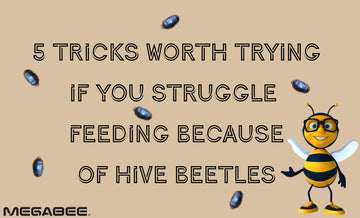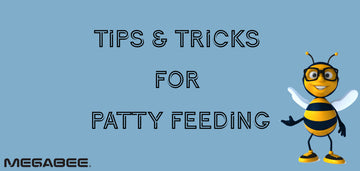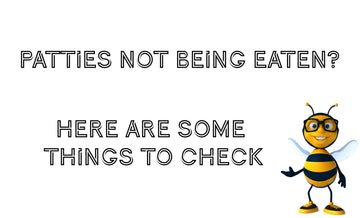5 tricks worth trying if you struggle feeding because of hive beetles:


We all know what a nuisance hive beetles can be when you’re trying to feed supplements to your hive, but there are a few tricks you can try to curb your hive beetle problem and still make sure your bees are getting the nutrition they need:
1. Feed as a liquid – Let’s get one obvious thing out of the way: Hive beetles love patties. But the beauty of MegaBee is that because we grind it so fine, it is the only protein feed on the market that you can also feed as a liquid. If you already feed sugar syrup then you’re in luck, just mix a little MegaBee into your feeder and you can give your hive all the beneficial nutrition it needs without adding another step to your hive-management routine. In general, beekeepers find that this method works better with hive top feeders as opposed to division board feeders. This is largely due to the fact that division board feeders are open to the environment and hive beetles have a tendency to crawl into the syrup and deter bees from consuming the syrup. So try mixing up as much as a two cups of MegaBee powder into a gallon of 2:1 heavy syrup. If you have questions about mixing MegaBee as a liquid, check out our MeagBee U article on liquid feeding.
2. Feed smaller patties – One of the easiest ways to get overrun by hive beetles is to give your bees more food than they can handle. For many beekeepers, the days of putting 4 pounds of patties on a hive and coming back weeks later are long gone…and if you’ve opened up your hive and stared in horror at what you think used to be your patty (but now resembles a dead animal) then you know what I’m talking about. Feeding smaller patties can make a world of difference. For starters, try halving your patties and only giving them what they can eat in a few days. The goal here is to get a feel for that correlation between hive size and patty size. As your hive continues to grow and colony population numbers increase you’ll notice that they will be able to handle larger portions of patties.
3. Add a little sugar, oil, or an essential oil mix – Feeding in an area with hive beetles is a race against time, and if we are looking to get quality nutrition to the bees before the hive beetles catch on then sweetening the deal can help. Consumption rates tend to skyrocket when adding sugar, oil, an essential oil feeding stimulant (like Honey Bee Healthy). Much like feeding a child, the biggest thing to make sure of it that you are still giving your hive quality nutrition…not just a sugar rush. Next time you try mixing up your own patties mix equal parts MegaBee powder and sugar, add 4% oil of your choice (2-3 tablespoons per patty), a little HBH or something similar, and enough 2:1 sugar syrup to get it to patty consistency. Note: you will need less syrup than usual with this recipe because the added sugar will thin out the patties.
4. Candy boards – Candy boards can be a great way to combat hive beetle issues, and they’ve been used in beekeeping for decades. By mixing MegaBee into the candy right as you take it off the heat you can create a nutrient-rich delivery method that your bees are sure to love. Why do candy boards work so well? You guessed it…beetles can’t bore into it and lay their eggs. Combine that with the fact that you can pack over ten pounds of product into a hive cover at nearly 10% protein and you’ve got a long-term solution for both hobbyist and commercial beekeepers. Want to know how to make one? Check out our article on candy boards.
5. Get creative – Any trip through the threads on Beesource is sure to give you some zany ideas, but here are a couple that might actually be worth your time:
- Add a spacer to your hive cover. Here we are talking a different type of “bee space.” Try adding a 3/4” rim just under the hive top. This allows the bees in the hive ample room to surround the patty, which surprisingly discourages hive beetles. The only asterisk here is that you need a strong hive with plenty of bees on the top bars in order for them to fend off beetles.
- Put your patties in wax paper bags. Unlike the previous suggestion, this potential solution focuses on limiting the exposure area instead of increasing it, which means that it is perfect for smaller/weaker hives. Simply place your patty into one of these wax paper bags and make an incision in the top of the bag with your hive tool. Since the bees can limit the exposure to a small area they are better able to fend off any beetles that may be present. Makes sense, right?
The biggest thing to remember here is that hive beetles are just like every other pest in a hive—they are vultures. Much like hive beetles or fire ants these little havoc wreakers become less of an issue in stronger hives. So in summary, the best thing to do is focus on growing your hive as best as possible. Keep your patties small, place them as close to the brood nest as possible or if it has to go on the top bars use a spacer, try adding something to speed up consumption, and if all else fails—get creative.



